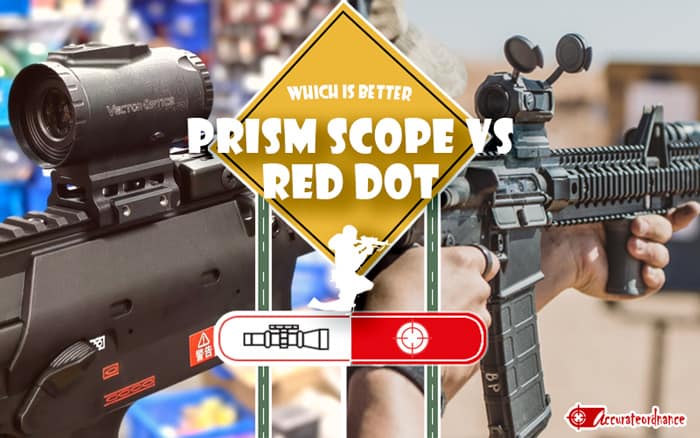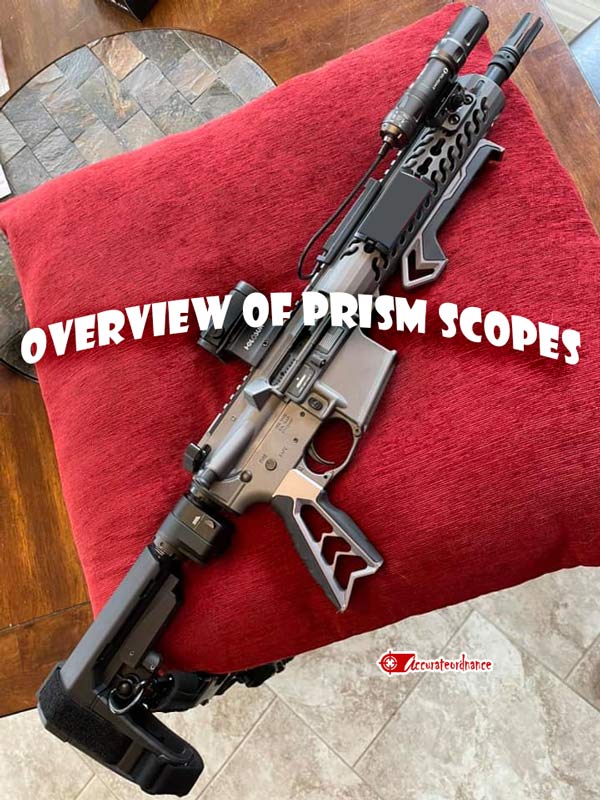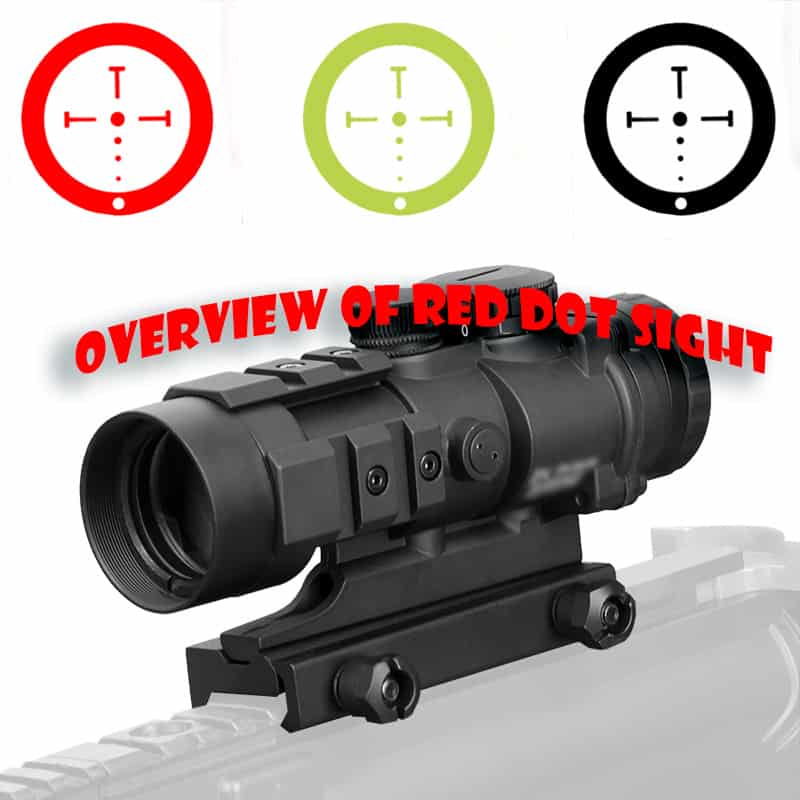
As a gun owner, one thing you have to be familiar with is the different types of sights that you can use to make your shooting experience better. There are different types of sight and optics that can help you aim better and improve your shooting accuracy. If you have been using a close range weapon for duty or competitive shooting in the past few decades, you must have noticed the transition and revolution in the optics market. Firearm optics have transitioned from an iron sight to red dot optics and other recent hybrid shooting optics.
The prism scope is a newcomer on the market. This is easy to tell because many people do not understand what it is, how it works, and how it differs from a red dot sight. So if you’re looking for a way to fill that information gap, you’re at the right place.
In this article, we would be highlighting the difference between prism scope vs red dot sight. Hopefully, at the end of this comparison, we’ll have addressed all of your questions and you’ll know which scope is most suited for your shooting application.
Let us start with the prism scope…
- Overview of Prism Scopes
- Overview of Red Dot Sight
- Features of a Red Dot Optic
- Comparison Table
- FAQs
- Differences Between Prism Scope and Red Dot Sight
- FAQs
- Are prism scopes only suitable for long-range shooting?
- Can I achieve quick target acquisition with a prism scope as I can with a red dot sight?
- How do prism scopes achieve variable magnification, and how does it compare to the 1x magnification of red dot sights?
- Do prism scopes have compatibility with night vision devices like some red dot sights?
- Can I use a prism scope on different firearms, or is it designed for specific platforms?
- Are there any specific scenarios where red dot sights outperform prism scopes, or vice versa?
- Can I co-witness iron sights with a prism scope or red dot sight?
- What are the considerations when choosing between a reflex sight and a prism scope for an AR pistol?
- Are there any disadvantages to using a red dot sight in bright daylight conditions?
- How does the battery life of a prism scope compare to that of a red dot sight?
- Do prism scopes offer any advantages for shooters with astigmatism compared to red dot sights?
Overview of Prism Scopes

A prism scope is not the same as the regular rifle scopes that you know. A standard rifle scope functions similarly to a traditional telescope. These scopes are designed to capture a large amount of light and then concentrate what they have collected on a specific point. We won’t go into details on the scientific explanation of how scope works, here’s how we’d put it simply:
Light enters through the objective lens of the optic into the ocular lens which is the focus point. That’s just about what we can tell you on the basics of how scopes work. Let’s get back to the prism optic.
A prism scope, also known as a prismatic scope, is distinct in that it utilizes prisms to focus light. Because of their small size, manufacturers can easily update and add new features—features that you’d rarely find in a traditional scope. Prismatic sights are easier to use compared to iron sights.
Another thing about a prism optic is that they provide you with all that a standard rifle scope can provide, and then more. We’re talking about etched reticle, astigmatism, eye relief, magnification power, and everything else you can think of.
There’s no reason to wait any longer now that we’ve stated them. Let’s just get started.
Reticle
One of the major areas where a prism scope outperforms other optics in the market is in the reticle. This optic device appears to have been particularly built to accommodate various reticles, a perfect hybrid I’ll say!
If you are searching for the best prism scope that can be used for different purposes, then you should consider the one that has a duplex reticle. Do you need a scope that could ensure peak performance in mid-range and long range shooting? Try out the Bullet Drop Compensator reticle. If you want the best prism scope with low magnification power, then the red-dot reticle is the way to go.
We also have to mention the illuminated reticle and etched reticle on prism scopes. Most prism scopes have etched reticles, meaning that the reticles are carved on the scope. If you are the type of shooter that doesn’t like the idea of an illuminated reticle and power cells, then you can stick with the etched reticle on this scope
In summary, if the only thing you care about is the type of reticle and what it can accomplish, you can ditch the regular rifle scope and get a prism sight. In the event that the battery fails, the etched reticle function will remain active.
Magnification
We can’t ignore this feature, no matter how much we want to focus on the advantages and overlook the downsides. The reality is that a prism sight is not intended to provide variable magnification. In fact, this is why it’s usually a good idea to evaluate your shooting needs before buying a scope. You don’t want to purchase a sighting device that will be useless in the field.
If you’re looking to buy an optic to help you hit a target that’s about 300 yards away, your best choice would be a prism scope that has a 5x magnification power.
Lenses
The lenses used in a prism scope are similar to those used in a traditional scope. The mechanism that houses them is the only difference.
Presently, most optic lenses have some kind of coating. Some even have numerous coating layers. These coatings’ principal role is to protect the lenses and the sight mechanism from reflected light and glare. It is almost impossible to see a scope that has lenses and does not have an anti-reflective coating.
Remember, the more layers there are, the more protected the lenses of the prism scope are.
Brightness
We once conducted a brightness comparison of prism scopes and other sighting devices on the market. Our research only confirmed what we suspected all along: their illumination level is unparalleled.
Even under low light, the sight picture generated was brighter than those produced by the other lenses. And there’s only one possible explanation. When it comes to light transmission, prism scopes are far more efficient. It was all we needed to determine whether or not this technology was suitable for rapid and easy target acquisition.
Eye Relief
Does it matter to you how wide a scope’s eye relief is? If you answered yes, you will most likely despise the prism scope. Prism scopes do not have unlimited eye relief like the red dot sights.
Assume you’re shooting a gun with a lot of recoils. In most cases, you’ll require at least 5 inches of eye relief. Unfortunately, most prism scopes cannot give you more than 4 inches. That implies you’ll be dealing with ‘scope bite’ on a regular basis. A prism scope is only recommended for semi-automatic rifles, the ones that do not use heavy ammo..
Parallax
Even the finest prism scope on the market will not provide you with a parallax-free experience. Despite being radically different from typical scopes, they face the same problems as their peers. Though there is some great news: those concerns will not be as severe as they are when using a traditional scope.
Excellent for Astigmatism, No Co-witnessing
You won’t be able to align your iron sights with a prism scope if that is what you’ve been anticipating. Only by removing the scope from your rifle will you be able to use those iron sights.
Prism scopes are great at dealing with astigmatism because they contain adjustable diopters that help shooters who suffer from that ailment to alter the optic’s mechanism to a point where they feel comfortable while focusing on an image.
Overview of Red Dot Sight

Why the red dot? When talking about a red dot sight, the dot in this context refers to the shape of the reticle, whereas the red indicates the color of the dot. Let me also remind you that the term “Red Dot” is a bit general. It is frequently used to explain or describe numerous sighting systems that yield comparable outcomes. We can say that a sight is a red dot sight if it is meant to project a red reticle on a target.
But it doesn’t mean that they all work the same way or have the same distinguishing features. In general, we would classify red dot sight into one of three categories:
- Holographic sight
- Reflex sight
- Prismatic scope
We’ve previously gone over the prism scope, there’s no need to go through it again.
Holographic Sight
They’re known as a holographic diffraction sight or holographic weapon sight. A holographic weapon sight is different from the other listed optics because it has no magnification and sometimes uses holographic reticles.
How is it even possible? First and foremost, it will record the light reflected off the landscape. It will then analyze that data and redesign the light field in the viewing area of the optic. The reticles of the holographic optic are generally three-dimensional, but if you prefer dealing with two dimensions, they’re also readily available.
A holographic sight does not have a tubular shape. This is another distinction that you should be aware of. It has a rectangular window, which is why people who enjoy working with a larger field of view tend to gravitate toward it. The best thing is that the way they’ve been constructed allows shooters to shift their heads around without feeling pressed to find a fresh aiming position.
Reflex Sight
Reflex sights are also known as reflector sights because they use LEDs to cast dots onto the ocular lens. The ocular lens is the lens closest to the shooter’s eye and functions as a mirror substitute. As a result, the target’s image is normally a little darker than usual. Examples of popular reflex sights are Holosun 510C and Aimpoint PRO.
You must also be aware that reflex sights are divided into two types: small and tubular. The first has an exposed beam, whilst the latter does not. Furthermore, the tube-like reflex sight resembles a small rifle scope.
What are the differences between open reflex sights and closed reflex sights?
There are clear distinctions between open reflex sights and closed reflex sights. Open models are open to external influences: the open model’s light source is housed in a (partially) open structure. Dirt, snow, or rain can obscure or distort the light source, causing the illuminated dot to seem blurry. Closed reflex sights contain the light source within an enclosed housing and are hence immune to such impacts. As a result, these versions can be used in any weather without issue.
Features of a Red Dot Optic
Compact Size
The first thing you’ll notice when you hold a red dot sight is its simplicity and size. If you purchase the tubular ones, you’ll see they’re about the same size as the Rifle Combat Optic. Because red dot sight is so small, most shooters have resorted to utilizing them with handguns.
Adjustability
Can elevation and windage be changed? They certainly can. If you have ever used a feature like this before, you’ll recognize it. It is vital to establish a correct zero for this device.
You should be aware of this by now. Nowadays, most hunters favor the Kentucky windage. Rather than changing the sight, this form of modification is intended to compensate for wind by pointing the weapon to the target’s left or right.
Battery Life
Red dot sights usually have a LED or Laser. They’re also incredibly efficient since their power cells can run for hundreds of hours before running out. The batteries can also conserve energy since they fall into sleep mode when left idle for lengthy periods of time.
Illuminated Reticles
As previously stated, the red dot is produced using an illuminated reticle. The source of illumination for this reticle will be determined by the manufacturer. A LED or laser might be used. You might also use a knob to make changes based on the light conditions or your personal preferences.
You might be tempted to work at a higher brightness level. Keep in mind that it will ultimately strain your eye muscles.
Comparison Table
| Prism Scopes | Red Dot Sights | |
|---|---|---|
| Magnification | Variable magnification, typically ranging from 3x to 5x or higher | No magnification, features a single aiming point or dot |
| Reticle Types | Etched reticles, available in various designs including crosshairs, BDC reticles, and illuminated reticles | LED-generated aiming point or dot, options may include single dot, multiple dots, circles, or reticles with bullet drop compensation |
| Battery Life | Longer battery life as the reticle remains visible without battery power | Varies depending on the model, can range from a few hundred hours to thousands of hours |
| Power Source | May require batteries for illumination features | Relies on battery power to project the aiming point or dot |
| Size and Weight | Larger and bulkier, due to the prism lens system and additional magnification components | Compact and lightweight, designed for low-profile and ease of use |
| Portability | Less portable due to the larger size and weight | Highly portable, ideal for easy maneuverability and mounting on various firearms |
| Use Cases | Suitable for long-range shooting, hunting, tactical operations, and precision shooting competitions | Ideal for close to mid-range shooting, competitive shooting, law enforcement, home defense, and close-quarters combat |
FAQs
Do red dot sights have night vision?
At night, red dot sights perform admirably. One of their main advantages is that they are lighted, so you don’t have to use a black optic reticle or black iron sight against a dark backdrop. A variable light intensity red dot sight is extremely useful in low-light circumstances. The intensity that works in broad daylight may not work at night. Reduce the brightness to match your surroundings and create an easy-to-work-with sight picture for yourself. A red dot sight is good for night vision and also has unlimited eye relief.
Which is superior, green or red dot vision?
The choice between a red dot and green dot sights is purely subjective. Red is the color of choice for the majority of individuals. Red dots, on the other hand, put greater strain on the eyes than green dot sights. Many senior shooters, as well as those with astigmatism, benefit from using green dot sights since it reduces eye strain.
Does this imply that the Red Dot Optic has an advantage?
The truth is, when it comes to red dot and prism scope, even though red dots are inexpensive and adaptable, they aren’t for everyone. For starters, they rarely provide magnification or any type of optical distortion. You will only see the red dot on the target. This can be a problem, particularly for a long range shooter.
I could guess what you’re thinking. You’re probably asking why anyone in their right mind would contemplate purchasing a sighting gadget with no magnification. As always, the answer is straightforward. It has a larger Field of View, making target acquisition easy and fast.
They are also effective across short distances, consume little energy, and are quite dependable. Their accuracy and precision are, as one would assume, at an all-time low. However, consider the speed advantage that you would get with follow-up strikes. Don’t you think it is worth it?
The type of reticle found in a red dot sight is also a disadvantage. Their reticles are not as sophisticated as those on prismatic sights. This, along with the lack of magnification power, means that the shooter will have to rely on guessing when they want to take shots that are a little farther.
Whichever gadget you purchase should be one that you believe will provide excellent value. Don’t choose anything merely to seem cool or because everyone else is doing it.
Differences Between Prism Scope and Red Dot Sight
Prism Scopes and Red Dot Sights are two popular types of optics used for firearms, each offering unique features and advantages. Let’s explore the differences between these two optics categories in more detail:
Magnification and Optics
Prism scopes are meticulously crafted with fixed magnification levels that typically span from 1x to around 5x. They make use of an intricate arrangement of prisms and lenses and give shooters a conventional riflescope-like viewing experience. This makes them well-suited for medium-range engagements and increases the target identification capabilities.
In contrast, red dot sights boast non-magnifying optics set at a 1x magnification factor. These sights lean on a singular reflective lens and a brilliantly illuminated reticle, and they overlay a straightforward aiming point directly onto the target. Renowned for their swiftness in target acquisition, red dot sights excel in close to medium-range scenarios, where quick response and precise aiming are key.
Reticle Types and Sighting Systems
Prism scopes stand out with their diverse range of reticle choices, including bullet drop compensation (BDC) reticles. These sophisticated designs are meticulously calibrated for specific ammunition calibers, permitting adept marksmen to account for holdovers and gauge distance. This makes them indispensable for meticulous shooting across varying ranges.
Red dot sights, in contrast, embrace simplicity with their signature reticle design—a solitary illuminated dot. This minimalist configuration delivers a seamless aiming point, an asset particularly valuable in confined quarters where agility and swift target acquisition reign supreme.
Battery Life and Power Source
Prism scopes do not rely on batteries for their operation, as they only need optical principles to provide magnification and reticle functionality. This eliminates concerns about battery life and power sources.
Red dot sights rely on batteries to power the illuminated reticle. While this allows for a bright and visible aiming point, it also means that users need to monitor battery life and have spare batteries on hand.
Size, Weight, and Portability
Prism scopes tend to be larger and heavier due to the additional lenses and prisms required for magnification. This can impact the overall weight and balance of the firearm, potentially affecting portability and maneuverability.
Red dot sights are compact, lightweight, and designed for minimal added weight to the firearm. Their portability and low profile make them well-suited for firearms that need to be agile and easy to handle.
Suitability for Different Scenarios
Prism scopes are favored by shooters who require magnification for mid-range engagements and more precise shots. They excel in applications such as target shooting, hunting, and competitive shooting, where accurate range estimation, bullet drop compensation, and improved optics are essential.
Red dot sights are ideally suited for close-quarters and rapid target engagement scenarios. They shine in situations like home defense, tactical shooting, and scenarios where quick target transitions are critical. Their ability to provide fast sight acquisition and situational awareness makes them effective tools for dynamic shooting situations.
FAQs
Are prism scopes only suitable for long-range shooting?
No, Prism scopes cannot be used at long distances. They are meant to be used for medium-range shooting. Their magnification and reticle options make them effective at this distance. However, you cannot use them for close-range shots too.
Can I achieve quick target acquisition with a prism scope as I can with a red dot sight?
Yes, you can. Even though they perform best in medium range, they are known for their quick target acquisition.
How do prism scopes achieve variable magnification, and how does it compare to the 1x magnification of red dot sights?
Prism scopes use internal lenses to adjust the magnification level, allowing you to zoom in or out. This is different from red dot sights, which typically have a fixed 1x magnification, providing simple aiming point without zooming. The main difference here is the prism that gives prism scopes a zoom ability.
Do prism scopes have compatibility with night vision devices like some red dot sights?
Some prism scopes are compatible with night vision devices, but not all of them. If you plan to use night vision, make sure to choose a prism scope that has this feature.
Can I use a prism scope on different firearms, or is it designed for specific platforms?
Prism scopes can be used on different firearms, including rifles, carbines, and even some handguns. However, it’s essential to ensure that the scope is compatible with the specific firearm’s mounting system and recoil strength for optimal performance.
Are there any specific scenarios where red dot sights outperform prism scopes, or vice versa?
Red dot sights excel in scenarios requiring rapid target acquisition at close distances, such as close-quarters combat or quick-moving targets. Prism scopes shine in situations where precise aiming and variable magnification are needed, like mid-range shooting or engaging targets at different distances
Can I co-witness iron sights with a prism scope or red dot sight?
Yes, you can co-witness iron sights with both prism scopes and red dot sights. Co-witnessing allows you to use your iron sights as a backup aiming method in case your primary optic fails, ensuring you can stay on target.
What are the considerations when choosing between a reflex sight and a prism scope for an AR pistol?
When selecting between a reflex sight and a prism scope for an AR pistol, consider factors like your intended shooting distance, speed of target acquisition, and the need for magnification. If quick aiming at closer ranges is crucial, a reflex sight might be ideal. If you anticipate engaging targets at various distances and want magnification options, a prism scope could be a better fit.
Are there any disadvantages to using a red dot sight in bright daylight conditions?
Using a red dot sight in very bright conditions might result in the dot appearing less distinct or even getting washed out. To mitigate this, you can adjust the brightness settings or choose a sight with auto-adjusting capabilities.
How does the battery life of a prism scope compare to that of a red dot sight?
Prism scopes generally have longer battery life compared to red dot sights. This is because prism scopes often use etched reticles that remain visible even if the battery dies, whereas red dot sights rely on battery power to project the dot.
Do prism scopes offer any advantages for shooters with astigmatism compared to red dot sights?
Yes, prism scopes can be advantageous for shooters with astigmatism. The etched reticles in prism scopes often appear crisper and clearer to those with astigmatism compared to the dot reticles in red dot sights, which can sometimes appear distorted.

Mike Hardesty is a published freelance gun writer. He also possesses specialized expertise in rifle scopes With dozens of articles and reviews published in Pew Pew Tactical, Snipercountry.com, and TTAG (The Truth About Guns), Mike is considered a firearms expert. His special area of expertise is handguns.
Mike is a long-time shooter. He has been punching paper targets, taking deer and other game and shooting at competitions since about 1975. Other related pursuits include reloading and bullet casting. He currently reloads for over 10 calibers, both handgun and rifle. His reloads, particularly for 9mm, were in great demand during the height of the ammo shortage among family and friends. He donated hundreds of rounds to informal shooting sessions. He was quoted as saying “I do not sell my reloads but I sure will help my guys shoot ’em for free!”. He has a few cherished firearms that he has inherited or otherwise procured — those are his favorites.
He earned B.S. and M.S. degrees from Indiana State University in 1974-1975.
He’s a firearm experts and is the founder of mhardesty.com.
